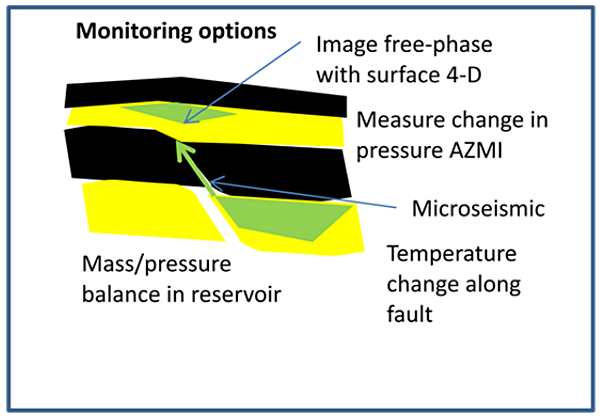Research Theme 3
Monitoring Methods Optimization

A variety of monitoring options are possible at geological sequestration sites
Theme 3: Monitoring Methods Optimization [PDF]
Monitoring optimization of geological carbon sequestration at GCCC focuses on four monitoring zones: in zone, above zone, shallow groundwater, and vadose zone. Our work includes field demonstration, laboratory studies, and assessments.
Accomplishments
- Developed new monitoring tools and approaches: for example, a process-based method of using gas ratios to attribute sources of anomalies and time-lapse compressibility to assess change/no change in fluid in a zone.
- Analyzed dense monitoring data from 2008 to the present from the research-oriented program at Cranfield, Mississippi.
- Designed a monitoring plan for two commercial enhanced oil recovery (EOR)projects sourced from anthropogenic (captured) CO2 (Hastings and West Ranch, Texas).
- Produced assessments of methods for optimization of monitoring approaches including site-specific sensitivity of tools (Hovorka, S. D., Zeidouni, Mehdi, Sava, Diana, Remington, R. L., and Yang, Changbing, in revision, 2014, Site-specific optimization of selection of monitoring technologies, in Carbon dioxide storage in deep saline formations: v. 4, CPL Press and BP.), sites with storage via EOR (Wolaver, B. D., Hovorka, S. D., and Smyth, R. C., 2013, Greensites and brownsites: implications for CO2 sequestration characterization, risk assessment, and monitoring: International Journal of Greenhouse Gas Control, v. 19, p. 49–62, dx.doi.org/10.1016/j.ijggc.2013.07.020.), and statistical methods for optimization of well placement.
- Transmitted information to industry and regulatory participants (see Outreach, Training, Policy and Regulation Theme for more information).
Impacts
- Pioneered pressure surveillance of above-zone monitoring intervals (AZMI) as a robust, commercial method of assessing storage permanence.
- Provided fit-to-purpose monitoring tools for response to changes (time-lapse compressibility and process-based method) (see Natural Analog Studies Theme for more on process-based method).
- Improved conceptualization of fluid flow using multiple methods in a cross-well array.
- Developed a pragmatic approach to monitoring large-scale injection with full industrial participation.
- Enabled the private sector to develop an economically viable CO2 sequestration industry.
- Assessed and demonstrated limits, as well as strengths, of monitoring methods that support parsimonious commercial plans.
- Generated valuable experience using monitoring data for input into a fluid-flow model.
Major Projects
- SECARB Cranfield 2008–17 [PDF]
Multiyear, multimillion-ton injection with a focus on the water leg of an EOR project. - Monitoring design and implementation for commercial capture to EOR projects [PDF]
Working with industry partners on commercial projects has sharpened the understanding of optimization of monitoring, including thermal and time-lapse pressure methods. - Pressure-based inversion and data assimilation system (PIDAS) [PDF]
The PIDAS system is developing a harmonic pulse testing technique for detecting leakage from CO2 storage formations and data assimilation and inversion algorithms for incorporating this technique into operational monitoring programs. - EPA-CCP site-specific monitoring study [PDF]
This study undertook a novel assessment of how site-specific properties impact development of monitoring strategies at geological sequestration sites. (See Natural Analog Studies Theme for information on additional monitoring associated with industrial and natural analog sites.)
Personnel
- Susan Hovorka
- Tip Meckel
- Rebecca Smyth
- Ramon Treviño
- Vanessa Nuñez
- J.-P. Nicot
- Changbing Yang
- Mehdi Zeidouni
- Alex Sun
- Katherine Romanak



